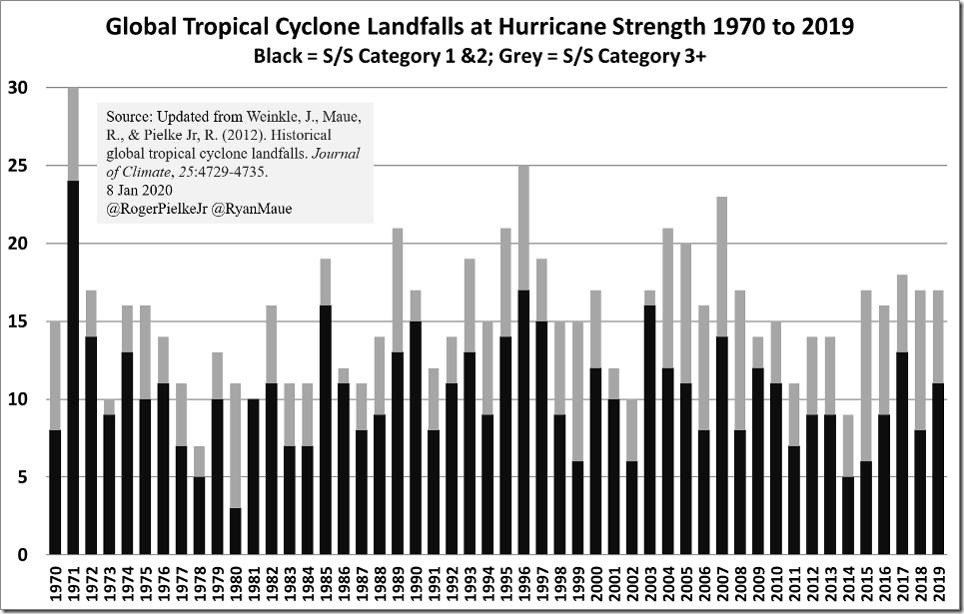Hurricanes and The AMO
By Paul Homewood
Bob Vislocky makes a valid comment about the Pielke graph on hurricane landfalls, which I posted on the other day:
Actually, the chart is quite deceiving the way it’s plotted with the gray bars added to the top of the black bars. The gray bars are for Cat 3+, so if you only plot those there is a significant increase in major landfalling hurricanes. Here’s the breakdown by decade:
1970s = 38
1980s = 41
1990s = 55
2000s = 58
2010s = 60Since there’s no overall trend in the total # of hurricanes (cat 1-5), what’s happening is there’s a decrease of Cat 1&2 storms because some of those that form have been turning into major hurricanes more readily over time. Now some of that increase could probably be attributed to better measurement, sensing & detecting, but probably can’t explain all the increase away.
I must admit I hate these sort of graphs. However the reason for this apparent rising trend of major hurricanes becomes apparent when we look at the longer trends.
Pielke also includes the graph below, with data back to 1950, along with this commentary, in his Forbes article, which I reposted:
It is well known that the 1970s were a relative quieter period for tropical cyclones overall as compared to the 1990s, and parts of recent decades.
With our data, we can say a bit more about longer-term trends because reliable records of tropical cyclone landfalls in the North Atlantic and the Western North Pacific are available further back in time (to at least 1900 and 1950 respectively). Landfalls in these two basins account for about 68% of all global landfalls from 1970 to 2019.
The figure below shows a 10-year moving average of tropical cyclone global landfalls from 1950 to 2019. The period from 1970 to 2019 is based on observations and uses data identical to the graph above. The black line shows all tropical cyclone landfalls of at least hurricane strength and the dashed black line shows all landfalls of tropical cyclones of major hurricane strength. For the period 1950 to 1969 we have used actual data on landfalls in the North Atlantic and Northwest Pacific, and added to that the average number of landfalls from the rest of the world based on observations from 1970 to 2019 (there is no trend over this period). The grey line and dashed line represent an estimate of, respectively, total hurricane-strength and major hurricane-strength tropical cyclone landfalls from 1950 to 1969. The dotted lines represent plus and minus one standard deviation from this average.
In short, the numbers since 1970 are identical to the top graph. The numbers from 1950 to 1969, however, are based on actual landfalls for the N Atlantic and NW Pacific, added to the average for the ROW between 1970 and 2019. The dotted line is major hurricanes.
As we can see, major hurricanes were just as frequent in the 1950s and 60s as they are now. We have what appears to be a cyclical pattern, and not a straight line increasing trend.
There is actually no surprise about this at all, because it is all linked into the Atlantic Multidecadal Oscillation. NOAA describe its effect:
https://www.aoml.noaa.gov/phod/faq/amo_faq.php
We have been in the warm phase since the mid 1990s, just as we were in the 1950s. In between, the AMO was cold.
Comments are closed.



There is another possible explanation, namely that some are being classified not as category 1 or 2 but as category 3 hurricanes.
It has been noticed in Australia that some cyclones (hurricanes south of the equator) look threatening in the news but wind speeds drop drastically as they cross the coast where there are more observers.
All nonsense, we can rely on the Bureau of Meteorology for accurate data, can’t we?
I think it is the opposite, what were Cat 4s & 5s have reduced in power to Cat 3s at landfall.
Despite all the hype and use of Satellite top of Hurricane wind speeds.
https://www.msn.com/en-gb/news/empowering-the-planet/ocean-temperatures-are-the-hottest-since-records-began-after-global-warming/ar-BBYVmcI?li=AAnZ9Ug
Slàinte Mhath!
George
I am immediately suspicious of any data broken down by decade – why would that show anything meaningful?
We are looking at between 3 and 6 hurricanes on average each year, so I assume the actual figures are between perhaps 0 and 9. Thus any arbitrary division of years can produce all sorts of apparent but meaningless figures.
If we take the 0-9 as being “normal” but random, we will of course get spurious trends and cycles over relatively short periods of data. If I throw a dice fifty times and divide the throws into groups of ten I would very surprised if I didn’t get pretty different totals.
If it can be used to create alarm it’s climate change, otherwise it’s natural variation. Climate obsessives don’t want to be confused by realities like the AMO.
There is no money in it for them for telling the truth.
On finance, the boss of Black Rock finance intends to provide a worse performance for investors by taking decisions that account for the imaginary climate change. He produced this classic ‘Even if only a fraction of the projected impacts is realised’. I guess he doesn’t know that none of their predictions has ever come true. Ignorance is not a good trait for an investment manager.
What explains the obsession with the North Atlantic Basin? It’s just one of six basins where tropical cyclones form and a minor one at that. Pls see
https://tambonthongchai.com/2019/11/14/hurricane-obsession/